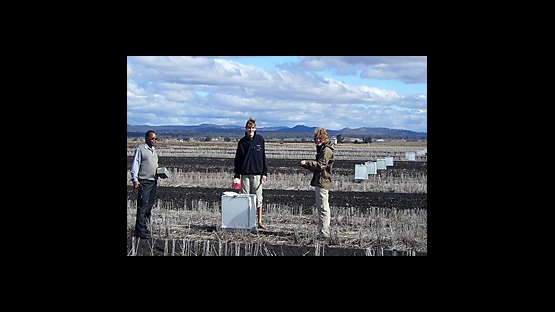Experts say that healthy, properly managed agricultural land increases crop yield and can contribute significantly to the reduction of harmful greenhouse gases like carbon dioxide, methane and nitrous oxide.
These gases occur naturally in the atmosphere. But when they are emitted from the soil, it's because farmers are employing poor soil management techniques, like applying the wrong fertiliser at the wrong time.
"Since 40 percent of the world´s land is used for agriculture, it is critical that this land is managed well," says Long-Minh Nguyen, Head of the IAEA's Soil and Water Management and Crop Nutrition Section.
Improving agricultural practices and reducing greenhouse gases are interrelated. In the soil, carbon and nitrogen are essential for plant growth. But released from soil into the atmosphere as carbon dioxide, nitrous oxide and methane, they pose a significant threat by contributing to global climate change.
When nuclear techniques are used to promote effective soil management (and thereby improve agricultural output), this helps to reduce the release of these gases into the atmosphere.
Scientists use stable and radioactive isotopes as well as soil moisture neutron probes to track the movement of nutrients and water from soil to plants. These isotopic and nuclear techniques provide fingerprints, which help to unravel the interactions between plants and soil - such as how much water is being stored in the soil.
Such knowledge helps scientists and farmers to develop soil and water management practices that enhance crop productivity and conservation of soil and water resources.
Elixir of Life
Soil is made up of minerals and organic matter, as well as living organisms. Organic matter has been referred to as the elixir of life, as it binds nutrients to the soil, improving the likelihood that crops will grow more, using more and more carbon from the atmosphere, creating a cycle that is beneficial to the atmosphere and plant agriculture.
Organic matter, which is essentially carbon, is comprised of dead plants, insects and animal remains that have decayed to the point of being unrecognizable. Soil organic matter is the second biggest carbon pool on the planet after the oceans. Enhancing the accumulation of carbon in soils (also termed carbon sequestration) has many benefits to global agriculture.
"It is more urgent than ever to act in favour of appropriate policies and practices that favour maintaining or even increasing soil organic matter levels," said Stavros Dimas, Commissioner for the Environment in the European Commission during a conference dedicated to climate change held in Brussels last year.
"If we manage to do that - and we have to do it now! - we have at our disposal a formidable tool for sequestering carbon and supporting the achievement of the targets we have set ourselves to combat climate change. The more organic carbon we keep in or add to the soil, the less carbon dioxide we will have in the atmosphere," he said.
"Nuclear techniques are used by scientists and farmers to see how different levels of irrigation, fertilisation and tillage can improve crop production. And by using better farming techniques we can help to improve carbon retention in soil and minimise the loss of nitrogen that comes from applied fertilisers and animal manure," says Nguyen.
Background
Soil organic matter is a home for bacteria, worms and insects, and allows them to transform plant residues, as well as releases nutrients that can be taken up by crops. It also maintains soil structure, which improves the soil´s ability to absorb and hold water, therefore avoiding soil compaction.
In addition, soil organic matter speeds up the breakdown of pollutants and can bind these harmful substances to its particles, reducing the risk of run-off into rivers and streams where people could be affected.
Many common agricultural practices, especially ploughing, disc-tillage and vegetation burning, accelerate the decomposition of soil organic matter and leave the soil susceptible to wind and water erosion.
The Joint Food and Agriculture Organization/IAEA Programme in Nuclear Techniques in Food and Agriculture advocates the use of conservation agriculture, the term used to describe alternative soil management practices that improve soil health and allow sustained agricultural productivity.
Conservation agriculture encompasses a range of good practices through combining no tillage or minimum tillage with a protective crop cover and crop rotations.
It also maintains crop residues at the soil surface, helps control weeds, enhances soil aggregation and keeps soil pores intact, in turn allowing water infiltration and reducing runoff and erosion.
In addition to making plant nutrients available, the diverse soil organisms that thrive in such conditions contribute to pest control and other vital ecological processes.
Conservation agriculture and a range of land management practices associated with this technique is not a silver bullet to enhance crop productivity and soil quality for every situation. It must be adapted to suitable soil types, soil fertility status and environmental conditions. The challenge for the IAEA's Soil and Water Management and Crop Nutrition Section is to assist Member States to evaluate conservation agriculture for specific situations.


